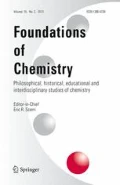Abstract
The foundations of modern organic chemistry were laid by the seminal work of Hughes and Ingold. The rise from being an interesting alternative hypothesis in 1933 to being the leading theory (outside the USA) in 1942 was achieved by a multiplicity of methods. This include:the construction of a new scientific notation, the rationalisation of some seemingly contradictory reported data, the refutation of the experimental work of one of their persistent critics, the use of conceptual arguments and also the achievement of a score of successful predictions which exceeded the score of unsuccessful predictions. Within the USA it was felt that the Hughes/Ingold system, whilst representing a considerable advance, had achieved spectacular success in spite ofits attractively simple basic assumptions, and represented merely an interim stage on the way towards a more comprehensive theory. However,the flexible, simple notation was adopted without modification, leading to a change in the way practitioners of synthetic organic chemistry were, and still are, trained to think.
In a conclusion the author claims that this historical episode does not lend any support to the philosophical position of Thomas Kuhn.
Similar content being viewed by others
REFERENCES
F.M. Akeroyd. Conceptual Aspects of Theory Appraisal: Some Biochemical Examples. Hyle 3: 95–102, 1997.
J.W. Baker. Electronic Theories of Organic Chemistry: An Introductory Approach. Oxford, University Press, 1958.
R.D. Brown. Kinked Molecules. Chemistry in Britain 23: 1189–1192, 1987.
P. Duhem (1905). The Aim and Structure of Physical Theory, English edition. Edited by P. Weiner, London, Atheneum, pp. 180, 183, 1962.
P.K. Feyerabend. Consolations for the Specialist. In: I. Lakatos and A. Musgrave (Eds.), Criticism and the Growth of Knowledge, pp. 212–213. Cambridge University Press, 1970.
E.S. Gould. Mechanism and Structure in Organic Chemistry, p. 1. NewYork,NY: Holt, Rinehart & Winston, 1959.
R. Guthrie and W.P. Jencks. IUPAC Recommendations for Representations of Reaction Mechanisms. Accounts of Chemical Research 22: 343–349, 1989.
P. Hoyningen-Huene. Reconstructing Scientific Revolutions: T. S. Kuhn's Philosophy of Science. Chicago, IL: University of Chicago Press, 1993.
E.D. Hughes and C.K. Ingold. A Series of 16 Consecutive Papers on Elimination Reactions and Nucleophilic Substitution. Journal of the Chemical Society: 899–1029, 1940.
W.P. Jencks. How Does a Reaction Choose its Mechanism? Chemical Society Reviews 10: 345–375, 1981.
I. Lakatos. History of Science and its Rational Reconstructions. PSA: 91–108, 1970.
L. Laudan. A Problem Solving Approach to Scientific Progress. In: I. Hacking (Ed.), Scientific Revolutions, pp. 144–155. Oxford University Press, 1981.
H.M. Leicester. Historical Background to Chemistry, p. 145. New York, Dover Edition 1971, 1956.
J. March. Advanced Organic Chemistry, 4th edition, pp. 293–300, 1992.
K.R. Popper. Logic of Scientific Discovery. London: Hutchinson, 1959.
K.R. Popper. Unended Quest. Fontana Paperbacks,revised ed. 1982. p. 229, n. 242, 1974.
W.v.O. Quine. Two Dogmas of Empiricism. In: From a Logical Point of View, 2nd revised edition. Harper, 1961, pp. 20–46, 1951.
L.A. Whitt. Conceptual Dimensions of Theory Appraisal. Studies in the History and Philosophy of Science 19: 517–529, 1989.
S. Winstein. Solvolysis of tert-butyl chloride. Journal of the American Chemical Society 61: 1635–1639, 1939.
J. Worrall. Revolution in Permanence. In: A. O'Hear (Ed.), Karl Popper: Philosophy and Problems, pp. 75–102. Cambridge University Press, 1995.
E. Zahar. The Problem of the Empirical Basis. In: A. O'Hear (Ed.), Karl Popper: Philosophy and Problems, pp. 45–74. Cambridge University Press, 1995.
Author information
Authors and Affiliations
Rights and permissions
About this article
Cite this article
Akeroyd, F.M. The Foundations of Modern Organic Chemistry: The Rise of the Highes and Ingold Theory from 1930–1942. Foundations of Chemistry 2, 99–125 (2000). https://doi.org/10.1023/A:1009942227721
Issue Date:
DOI: https://doi.org/10.1023/A:1009942227721




